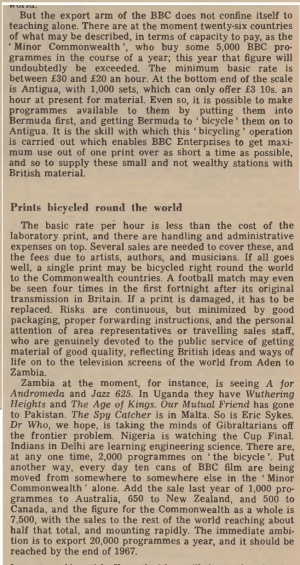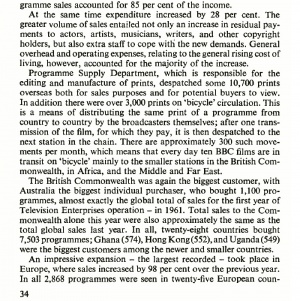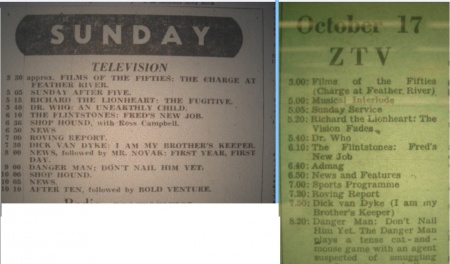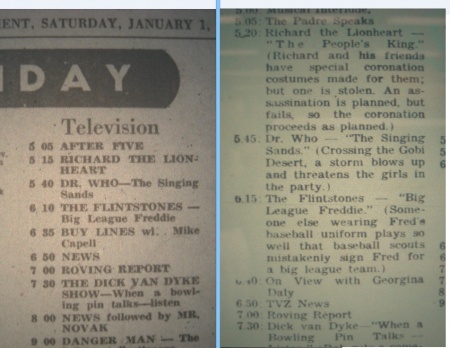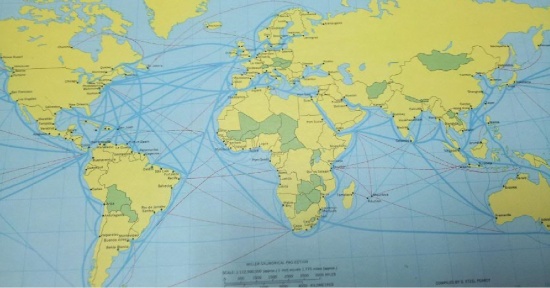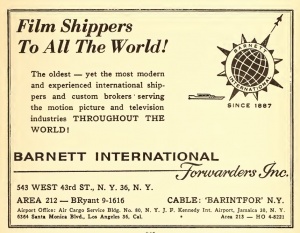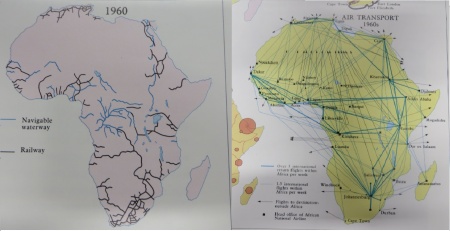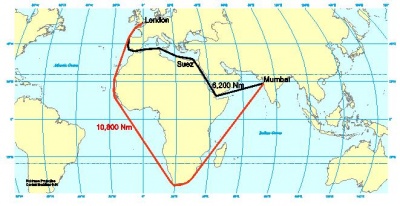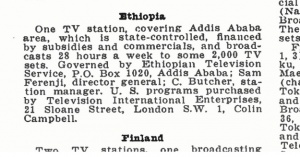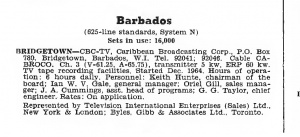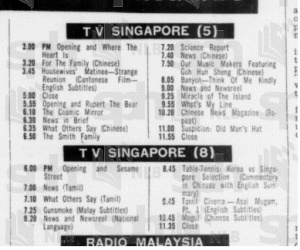Chains Intro
BICYCLING CHAINS: INTRODUCTION
The previous version of the Bicycling Chains was based around the (admittedly flawed!) concept that the transportation of films from country to country, from continent to continent was done mostly by air-freight, and therefore films could have been bicycled irrespective of geography.
In view of further research, particularly into the global shipping and transportation routes and methods of the 1960s, we have since concluded that the majority of films would have been delivered between continents by ship since air-freight would have been far too costly for the modest budgets of many of the smaller TV stations, particularly those 26 that the BBC classified as "Minor Commonwealth".
And with overland transportation mainly by rail, the distribution of films between countries in Africa (and therefore the Bicycling Chains they belonged to) would be restricted to existing railroad networks. As a result, we have reorganised the chains into more localised groupings based on these established transportation routes.
This page summarises the principal "new facts" that have influenced the thought-processes and analyses behind this revised set of Bicycling Chains. The Chains themselves are now on a separate page.
AUDITION PRINTS
The first three serials were used as the first Audition Prints early on. (Australia and New Zealand received just those three in 1964.) It would seem that in order to offer the brand new series to as many potential buyers as possible, those 13 episodes were sometimes sent outside of established bicycling groups – as evidenced by New Zealand supplying the films to Denmark, and Cyprus possibly supplying the same to Uganda. Therefore in all likelihood, as part of the Audition process the first two or three countries in each chain may have received those three serials from outside the chain they were to become a "link" of, and sent them elsewhere unaired - either within or outside their own chain. Those countries then received A, B and C again with the remaining prints being bicycled in once they had become part of a chain.
In the majority of cases countries were usually sent just one or two episodes (such as New Zealand sending parts one and two of Marco Polo to Iran in 1967, again, these were not aired) or at the most one or two complete serials (New Zealand received Jon Pertwee's first two serials as Audition prints in 1974).
On that note, the fact that the NZBC sent to Iran two prints from serial D rather than from serial A is telling – was this because the BBC didn't want sets of the first three serials split up? Would that also be true of the other sets that had been sent out for evaluation?
If the Audition process failed to attract a buyer, the prints would be sent back to the BBC or to another potential buyer. Iran purchased the series on the back of assessing two episodes of Marco Polo; that serial wasn't included in the package they subsequently acquired, so in all likelihood, the "Auditions" were sent back to the BBC in exchange for the purchased set, or sent to another country for assessment. Given that all the sales to Middle Eastern countries occurred in late 1967 / early 1968, it's possible that those two sample episodes did the rounds between various other countries in the same region, such as Saudi Arabia and Jordan.
By the late 1960s, as the sales to Commonwealth countries and elsewhere began to dry up, the BBC would have sent out recent serials as samples to countries in Europe -- such as an unknown Dalek story being sent to Norway in 1967, and The Ice Warriors going to Germany in 1968, only five months after its UK broadcast. (All the Dalek serials had been withdrawn from sale during 1966 and all of 1967. Only The Daleks and The Dalek Invasion of Earth appear to have been exempt from that arrangement with Terry Nation, so it's unlikely that the BBC would have been offering any of the other Dalek stories as an Audition if they were not actually able to sell them!) The BBC had obviously selected The Ice Warriors as a good example from the latest run of stories, and chances are that particular serial was the new Audition story to replace the one/s that had previously been used. (Is that why prints from that serial were found in 1988; they were a set of unused or returned Auditions?)
Since very little else is known about what was sent as Auditions and to whom, we have not even attempted to try and figure out and tabulate what happened to the early Audition Prints from the first four serials.
PRE-EXISTING BICYCLING CHAINS
A majority of the countries in Africa, the Caribbean and Asia had television for a number of years before they screened Doctor Who. And those countries would have been bicycling films already along the pre-existing bicycling chains that had been established in the early 1960s. The Doctor Who films would have been distributed along those same routes.
- The 23 June 1966 issue of the UK newspaper The Listener (illustrated at top right) notes how the skilled use of the "bicycling operation is carried out … to get maximum use out of one print over as short a time as possible" particularly within the "Minor Commonwealth" countries in Africa, the Middle East and the Far East (there were 26 such countries). Note also the remark about damaged films being replaced, and how risks of loss or damage are minimised by good packaging, proper forwarding instructions and attention by area representatives. It's possible that the odd Doctor Who print needed replacement as it travelled along the bicycling routes. (Is this why the BBC still had the odd "orphaned" print in the 1970s? They are spare replacement prints?)
- The 1967 BBC Handbook (see right) notes that of all prints that were distributed by the BBC the previous year roughly less than a third of them were subsequently bicycled, which means a lot of film was only ever used once.
One thing that is also abundantly clear from that article and the Handbook is that the bicycling system was ostensibly set up by the broadcasters themselves, not the BBC or other programme makers or distributors. The TV stations in neighbouring countries must have agreed on a share basis for programming by splitting the distribution costs. In the case of Doctor Who, the BBC was merely exploiting a robust system that was already in place for the sharing of (admittedly mainly US to begin with) film prints between countries in each region. (When Ian Levine visited BBC Enterprises in 1978, he recalled seeing "a big chart of the bicycling system as well", so the BBC was certainly able to track where prints could be and were being sent.) The year in which a country introduced its television service would also have affected its position within an established chain.
- Assuming the BBC started supplying programmes to Kenya soon after its television service was established in 1962 (a service which was ironically set up by Television International Enterprises – see below), a new chain would have been created in 1964 when Uganda commenced broadcasting. Cyprus had TV since 1956, and was probably supplied directly by the BBC and other distributors, but once Malta began its service in 1961, it went ahead of Cyprus in the chain because of its geographical advantage. In the Caribbean, Bermuda began a TV service in 1958. Trinidad started TV in 1962, with Jamaica joining the "chain" in 1963, and Barbados in 1964. Shipping to Bermuda may have been via one of the larger islands anyway, so once more stations commenced in that region Bermuda dropped to being merely a link rather than being at the start of the chain.
- It's clear that Rhodesia TV and Zambia TV had already been sharing films on a regular basis for many years: the TV line-up the night that Doctor Who debuted in each country is almost identical, with the same programmes scheduled (i.e. Films of the Fifties, Richard the Lionheart, Dr Who, The Flintstones, Roving Report, The Dick van Dyke Show and Danger Man) and in the case of four of those series it was the very same episode screening three weeks apart; and the same three-week-apart pattern continues for months down the line. It's clear from this that Doctor Who was simply slotted into a long-established bicycling chain that already existed between the two countries. (And when Zambia introduced regional screenings from March 1966, all the films from each night's schedule in Kitwe were transported overland to air again in Lusaka the following week.) How many other broadcasters operated under a similar permanent arrangement? (When trade sanctions and embargoes were imposed on Rhodesia in early 1966, how did that affect the Rhodesia / Zambia chain?)
- Since it's clear that Rhodesia and Zambia purchased and aired the same programming at the same time, this suggests that the programme buyers from both countries liaised with one another on a regular basis ("What are you buying this year?"; "Oh, we've been offered this new BBC thing called "Dr Who"; "Oh, okay, we might as well get it, then".) It's likely that similar arrangements were in place between other neighbouring countries around the globe. The Australia and New Zealand, and Hong Kong and Singapore programme buyers were certainly in regular contact with each other to find out what the other was purchasing, with the result that Country B bought Doctor Who not because it had been offered to them by the BBC but because nearby Country A was getting it, and it made financial sense for Country B to arrange with the BBC to buy it and split the delivery costs.
- As a further comparison, episodes from the BBC series Dr Finlay's Casebook were sold to Rhodesia in 1964 (series 1), while series 2 was sold to New Zealand in late 1965, Uganda by March 1966, Nigeria by June 1966, Zambia and Kenya both by February 1967, Hong Kong in 1967 (the films were bicycled from NZ), Barbados by October 1969 and Jamaica by July 1971. That particular run of episodes aired in Zambia during 1966 on the same night as Doctor Who; no doubt both series were transported together. But even without all the airdates, one can see that the prints would have been sent along the very same bicycling chains proposed here for Doctor Who episodes, so assuming the "sales" date reflects to some degree the transmission dates, one set of Finlay prints could have been shared by Rhodesia and Zambia (who we know regularly exchanged films), set two shared by NZ and Hong Kong, and another by Uganda and Kenya, with the two Caribbean nations sharing a fourth.
- TIE Ltd sold Sesame Street to countries in Africa from 1971. The order in which the countries are named in the Variety article (see below) could possibly reflect the order in which the films were to be bicycled: Ghana was the first in West Africa, followed by Nigeria and Sierra Leone, with Ethiopia the first in East Africa, followed by Zambia, Mauritius, Kenya and Uganda. The very fact that the sales to Africa were handled from TIE Sales's offices in London and that there were functioning bicycling systems already in place to handle distribution of the films around the continent and elsewhere (New Zealand sent a number of episodes to Singapore and Israel), means there wouldn't have been a need for TIE to operate its own central film distribution or storage "hub" within Africa. This is covered further below, and on the TIE Ltd page.)
Films were therefore being moved from country to country regularly and quickly along these pre-established chains; there was no real reason for any station to hold onto films for longer than necessary. Only the final country in each chain would be the one responsible for destroying or returning the films, otherwise by being at the end of the line they'd have mountains of expired films to store and administer. In most cases, destruction or return to the original supplier would be the ultimate fate of the films. (A third disposal method was to send some or all of the prints as "Audition Prints" to another broadcaster.) The BBC's "return or destroy" policy applied only to those countries that were at the end of each chain; the films were retained by the last country until such time that they received instructions to dispose of the prints in the manner dictated by the BBC. That directive sometimes came many years later, and in a few very rare cases maybe not at all… (This is covered below.)
And is it coincidence that most of the chains end in Africa? Was that the BBC's strategy from the beginning, to have films starting out at various points and continents around the globe but bicycled in such a way that they all end up in Africa? After all, from a perspective of longitude the continent of Africa is directionally south of the UK …
And with so few prints in circulation being shared by as many countries as possible the BBC's film laboratory and processing costs were kept down (as noted in the Listener article above); a fresh 30 minute 16mm print cost somewhere in the vicinity of £12 in the late 1960s, and when most countries in Africa were paying less than £10 per episode – and even less than that in the Caribbean - the BBC wasn't going to send a fresh print to a country paying less than the cost of that print if it couldn't recoup that cost elsewhere by bicycling. In other words, the BBC wasn't going to send a new print to a country if that film wasn't going to be subsequently bicycled. Therefore, we have where possible kept chains with just one country to a minimum.
SUPPRESSED or STORED?
And on that note, it's certain that the replacement Stored Field telerecordings that were introduced into the system in 1967 would have been delivered to a country at the start of a chain, rather than to a country within a chain. It's highly unlikely that the BBC would have gone to the effort and expense to intercept mid-shipment and withdraw the Suppressed Field prints already in transit between a chain of countries and replace them with a fresh set of Stored Fields. The BBC was certainly not informed or aware of upcoming foreign TV scheduling, and the broadcasters themselves wouldn't have known or even cared which version they were getting! (This is covered further as a note on the new Bicycling Chains page.)
SHIPPING FILMS AROUND THE WORLD
In the 1960s, the majority of films sent from London destined for Africa, the Caribbean, the Middle East and Asia would have been distributed by ship rather than by air, with rail or road for inland distribution to and from landlocked countries.
Minor Commonwealth TV stations with modest budgets simply could not afford to have films delivered to them by air from London all the time. (That's not to say air freight was never used -- it probably was! -- but unless there was an urgency, sea freight would have been the more common option for cost-effectiveness. In 1974, the only regular east Africa bound direct international commercial passenger flights from London were to Entebbe (Uganda) and Nairobi (Kenya); there were no regular direct flights to Zambia, so the existing flight paths affected what could be air-freighted in and to where. Of course, non-passenger cargo flights were not necessarily dictated by fixed air routes, but even so, cargo planes flying their own fixed routes between countries still had to use the same airports and facilities and undergo the same border controls and restrictions as passenger airlines (particularly if it involved movement of goods between countries that did not have a healthy political relationship); and freighting between countries sometimes required more than one change of plane.)
- Although movement of films by air was not that common, samples of various passenger airline timetables from the 1960s can be viewed here.
The BBC would have arranged to have the delivery of film prints to countries in East Africa go by ship, with the vessels stopping at Gibraltar then traversing the Mediterranean (with further stops along the way?), through the Suez Canal, then down the coast of Africa to the principal ports of call, then transported by rail and/or road to the final destination. These shipments were usually handled by specialist shipping agencies.
And it wasn't just a simple matter of crating up the films and putting them on a boat in the hope they got to their destination. Professional film shippers, exporters and importers and/or freight forwarders / clearing houses / bond stores were usually used for that purpose.
- One of the more prolific "film shippers" of the day was Barnett International Forwarders Inc, which had offices and agents in a number of countries (including Jamaica). They may well have been engaged from time to time to ship films on behalf of the BBC…
- And TIE Ltd regularly used the services of London-based firm B & B Couriers Ltd for transporting film prints from London by air or sea to and between the various TV and radio stations that TIE represented.
- The films destined for Kenya and Uganda would have been off-loaded at Mombasa (as evidenced by the 1968 "UK-Africa" shipping route reported here). Whereas the films destined for land-locked Rhodesia would have gone by ship (either around the cape of South Africa or via the Suez Canal), unloaded at Beira, Mozambique, then transported inland by train to Salisbury (now Harare). Shipping from mainland Africa to Mauritius also appears to have mostly gone via Beira.
- The map of world shipping lanes presented above is from 1966, and shows the main trade routes to and from Africa, Asia and the Caribbean along which some of the Doctor Who films could have been sent. When the Suez Canal closed in 1967 (see below), ships that would normally sail across the Mediterranean and through the Canal to Aden would have to be diverted around the Cape of Good Hope. Of note, there doesn't appear to have been any direct shipping between the West Indies and Africa, with all vessels going via Puerto Rico then to Gibraltar or London first, all of which would have had a bearing on the final overheads and costs of purchasing programmes.
- Passenger / mail / cargo ships operated on a regular basis (think along the lines of the SS Bernice from Carnival of Monsters), so who knows, some of the films may even have been transported on some of the ships in this FLEET LIST.
- Details of shipping routes (both passenger and cargo) for just 1971 (i.e. when the Suez Canal was closed – see below) are here.
- Other shipping routes and historical detail can be seen at the Maritime Timetables Image Archive.
In the 1960s, films were sent to Australia by ship, aircraft or parcels post, as is noted on existing paperwork. The surviving film registers held by the NZBC in New Zealand record that up until the late 1970s the broadcaster was regularly sending films to Africa, Asia, the Caribbean and Europe. Other extant film despatch slips indicate that in the 1960s the four methods used by the NZBC were Air-Collect, Air-Prepaid, Sea Cargo and Parcel Post. By the mid-1970s, the only delivery method cited on film despatch notices was Air Freight. While it's not recorded which method was used by the NZBC for each shipment it sent out, chances are the delivery method was determined by the destination, the number of films being transported and the urgency. A 6-part serial may have gone by air, whereas a batch of 20 or more episodes may have gone by sea. A non-urgent single film might have gone by regular parcel post. New Zealand's remoteness may be the sole contributing factor for the NZBC using four different delivery options, but it's likely that other broadcasters also employed multiple services on a case-by-case need.
- The cost of shipping or flying films from New Zealand and Singapore all the way to Nigeria, as was the case for The Time Meddler and The War Machines in 1973, must have been an option cheaper than bicycling from Gibraltar or striking fresh prints and transporting them from "near-by" London. (Although Gibraltar and Sierra Leone still held prints of those two serials until 1974, the BBC probably didn't want to break up either holdings as there was still sales potential in seasons one to three complete, whereas the prints held in New Zealand and Singapore were from broken sets and were therefore surplus and available for bicycling from afar.)
RAIL / ROAD
Films were bicycled on a "regional" basis along existing lines of transportation; in Africa, for instance, films would have been distributed by rail or road between countries in close proximity to one another, with the costs of transportation met by the recipient country.
Moving films from one side of the continent to the other – say from Ghana to Zambia – was not straightforward when there was no direct or continuous railroad linking the two sides of the continent. Although transcontinental air-services existed, not all flight routes between certain countries were direct, and the broadcasters would be wholly dependent on variable (and unreliable?) air-freight time-tables and other such factors, so shipping films on multiple flights would add to the overall administration costs. (As shown on the 1960s Air Transport map here, there were no direct flights from Ghana to Zambia, so planes had to go via Addis Ababa, Ethiopia and/or Nairobi, Kenya.)
- The railway linking Rhodesia and Zambia was closed between 1964 and 1980. One of the 1965 newspaper reports about the on-going non-appearance of Doctor Who in Zambia says that the missing films were due to be "flown" in from Salisbury (see the Zambia page for the clipping); this method of delivery was most likely a one-off occasion to ensure the timely delivery of not just Doctor Who but also all the other programmes that aired that night, all of which had already been delayed three weeks, to meet the fourth time lucky scheduled broadcast. All subsequent episodes may have gone from Salisbury to Lusaka by road, a journey of 354 miles / 570 km that would take around only seven hours.
- In terms of the maps shown here, shipments from east to west Africa may have gone via multiple methods: from, say, Zambia by rail to Lobito in Angola, then by ship to, say, Nigeria, Ghana or Sierra Leone.
Therefore, a permanent or regular transcontinental bicycling chain across Africa prior to 1970 is unlikely, therefore we not taken one into consideration in the tables.
However, as the number of sales dropped after 1967 (see below), intra- and later inter-continental bicycling became far more common purely out of necessity because the few countries still buying the series were reliant on the even fewer prints that were available for distribution globally. And since the bicycling chains were created and managed by the broadcasters themselves in order to minimise their overheads, who they shared films with, how they were delivered and the costs involved in moving them from A to B would have been established as and when, so acquiring films from, say, Barbados was something that Zambia TV would have set up themselves, not the BBC, as the only viable option if they wanted to continue to acquire BBC material.
CLOSURE OF THE SUEZ CANAL – 1967-1975
The Suez Canal was closed from June 1967 until June 1975, following the "Six Day War". Shipping that would normally have gone via the Mediterranean and the Red Sea was diverted around the Cape of Good Hope at the tip of South Africa. What impact would this have had on the distribution of Doctor Who?
One obvious consequence was that all the pre-existing bicycling routes within Africa (and elsewhere) had to change or be disestablished because delivery of cargo to East Africa had to go "the long way"; the longer journey would have been more expensive, and a further knock-on effect would be the odd delay in scheduling.
- From this website the distance from London to India via the Canal was 6.2k nautical miles, whereas the longer route was 10.8k nautical miles.
- The closure of the Canal may have been the sole reason why the chains that included Aden (which lay at the opening to the Red Sea), Kenya and Uganda stopped purchasing Doctor Who in that year.
Also of significance that year was that Britain abandoned its military presence east of Suez when Britain pulled out of Aden; the Mediterranean fleet, which had been based at Malta, was disbanded, and thus with the majority of the English-speaking TV audience (mostly ex-pat English workers or military) vastly reduced or gone completely from certain areas (with control of the British-owned TV stations transferring to the local governments) which may explain why so many countries in those regions stopped screening Doctor Who after 1967... (See also Who Bailed on Who First?)
A "Vicious Circle" was created: the loss of that major trade route meant that all delivery methods had to change, and so did the costs. The increase in costs meant that many countries could no longer afford to purchase certain BBC programmes, with the effect that some of the long-running bicycling chains could no longer be used. Fewer sales meant fewer prints in circulation, so those African broadcasters still purchasing the series had to acquire the films from "outside" the chain they had been in making it necessary to bicycle films in from other regions and continents (i.e. from as far as Asia and the Caribbean), thus further increasing the costs, so only those that could to do so would continue to afford to buy the series. (The fact that so few African countries were still buying the Hartnell and Troughton episodes of Doctor Who after 1970 is probably more likely due to the collapse of the chains than any other influencing factor. In other words, sales probably dried up because the chains fell apart rather than the chains collapsing because of lack of sales.)
The closure of the Canal therefore likely explains why Aden, Kenya and Uganda stopped getting Doctor Who after 1967, and with ships no longer crossing the Mediterranean to access the Canal as often as before, this may have been the reason why there were no further sales to Malta and Cyprus after 1967.
STORY GROUPS
With Doctor Who being sold in packages made up of specific serials or a set number of episodes (usually in "blocks" of around 26 episodes, such as A to E; F to L; M to S), countries that got the same groups of episodes were likely to be in the same chain – i.e. they got those episodes because the others in the chain did. TV stations bought Doctor Who generally with the standard right to screen the episodes within a three year period. It then became the responsibility of the purchaser to source and acquire the film prints; it wasn't the seller's responsibility. If the purchaser had regular channel within the same continent through which films were obtained, that source would normally be exploited first. But if that route failed to produce the goods, the purchaser would have to look further afield to find a station that had them. And that task may have taken months, which is why a three year sales period was given, since a good chunk of that time could be used up in just finding the films.
- The groups have been placed in order of "first to screen" the series. A BBC memo dated July 1965 lists the first ten countries to have been sold the series, and these are also the first ten to screen the series: we have therefore taken the approach that these ten were at the start of each of the bicycling routes. In most cases, these routes had already been established years earlier (as noted above); if Country A was already bicycling, say, Z Cars to Country B, who in turn sent it to Country C, it made economic and logistical sense to sell and bicycle Doctor Who to and between the same countries. But if it was only Country A and Country C that had bought a series, it made sense to try and flog it off to Country B as well, even if it meant charging them at the bottom end of the scale, since the films were already going that way anyway. This is expanded upon in the sections above.
- Of particular note, several countries in Africa and Asia stopped screening Doctor Who after The Rescue (a package of 53 episodes, a full years' worth) with only a handful continuing with the remainder of the William Hartnells or into the Patrick Troughton era. It's notable that when any one country in a chain stopped at The Rescue all the others along the same chain also stopped, since that particular supply route had been effectively closed – for instance, did Thailand stop the series at The Rescue because that's where Hong Kong stopped? (Again, refer to the table Who Bailed on Who First?)
- With the closure of the Canal and the British pulling out of Aden in 1967, effectively shutting down the "Aden / East Africa chain", was that why Uganda and Kenya did not acquire any more episodes? (This does raise the question as to why those two countries couldn't source the films locally from say Zambia or Mauritius? One possible answer is that Zambia and Mauritius were part of functioning chains into which the addition additional countries may have been logistically – and possibly politically? - problematic. For instance, if Mauritius received its films from Kenya via TIE Ltd's pre-existing delivery system, with say Uganda added to the chain, if there was no direct delivery method to move the films from Uganda to Mauritius, the films may have had to go back to Kenya first, before heading for their final destination, thus increasing the small island's overall shipping costs.)
- The two countries in east Africa that screened up to the end of season two, Zambia and Mauritius, and the only two countries in west Africa that screened up to The Time Meddler – Nigeria and Sierra Leone – would likely have shared prints at some time.
- And with Zambia receiving episodes from London via "the long way", the cost to purchase the series would have increased once the extra shipping distances had been factored in. And this extra cost may have been why Zambia stopped purchasing the series after 1968 – Gibraltar and Barbados had both dropped the series that same year, thus cutting off another possible supply-line, and Zambia couldn't always afford to acquire new (and more pricey) films directly from London (remember, as noted above, there was no direct flights between London and Zambia in 1974…) And it wasn't for another two years that Zambia picked up the series again with the Troughton stories, with the films being bicycled in (and thus cheaper!) from nearby Uganda. And when Uganda stopped getting the series after season four, Zambia had to source the prints of season five from elsewhere, which is why Gibraltar, who had picked up the series again after a six year break, became Zambia's supply source once again, for seasons five and six – i.e. Zambia only got those episodes because Gibraltar did. (In 1971, Zambia had become another country that TIE Ltd was a purchasing agent for; is that why Zambia was being supplied by Gibraltar again?)
SALES AGENTS AND DISTRIBUTION
Within some of these chains there may have been an intermediary, such as a sales, purchasing or distribution agency (e.g. the afore-mentioned Television International Enterprises Ltd sales agency, or even the BBC itself – the BBC had sales offices in Sydney, Toronto and New York) that received the films from Country A and was responsible for sending them on to Country B. (Films destined for Australia, New Zealand, Hong Kong and Singapore were air-freighted from BBC London to their office in Sydney for re-packing (often into plastic films cans manufactured by "Australian Reel Co") and distribution.) (The registration number of the aircraft on which the films arrived in Australia is recorded on the application to the censorship board; the carriers used most were QANTAS and BOAC: for instance, the first set of episodes were flown from London to Australia on a QANTAS Boeing 707.)
BBC's New York office may have been responsible for managing and supplying the prints into the Caribbean that were sold via TIE Ltd's sales division. There's a possibility that some of the films that were distributed within Africa were sent back to the BBC in London first, before being sent on to the next broadcaster.
Some programme sellers and distributors utilised a Customs or Bond service, through which films that were imported into a country were kept by an independent third party – a bond store – and released only once the purchaser had paid the seller. The ABC in Australia operated via such a system, and the surviving film traffic records from New Zealand record that the NZBC often sent films to different intermediaries in Australia and the UK. (NZBC did not send any films to TIE Ltd - see below.) It's not known how many other countries utilised this process.
- If a country was known to have been a customer of TIE Ltd, it is marked as such in the tables, although there is no absolute certainty that TIE played a part in managing or continuing to manage any of the chains that are depicted. It is fairly certain that TIE Ltd bicycled films between the countries that it represented
- Of note, the first three countries that TIE bought Doctor Who prints for – Gibraltar, Aden and Trinidad (which are bracketed together on other sales documentation) are located geographically as if those were the starting points for specific (and already-established) lines of distribution from key points around the globe: (1) Mediterranean / West Africa, (2) Middle East / East Africa, and (3) the Caribbean and South America. TIE would have met the cost of sending the films from its London base to each of the three locations, with the cost of moving them on to the next destination being met by the recipient.
- Also of note is that BBC sales records indicate that TIE Ltd acquired only the first five serials / 26 episodes for distribution to four countries in 1965. There is no other existing BBC paperwork that identifies TIE as the middle man, and there is no absolute certainty that they provided prints of any other serials sold to those four or any of the other (subsequent) countries that were in their distribution network. It may be that TIE Ltd acted as broker for those five serials / four countries only, and once the ink had dried on the sales papers for the first batch of episodes for those countries, TIE was out of the picture, and the sale and distribution of subsequent batches of serials was handled directly by the BBC (with the Caribbean sales via their New York office)...
- TIE Ltd helped a couple of the countries that aired Doctor Who in Africa and the Middle East to set-up their TV service, and they were contracted to have TIE act as their purchasing agent. (The set-up contract would have stipulated the terms and conditions by which the relationship between TIE and the TV station operated, and the length of time those Ts & Cs were in force. TIE would certainly not have been their only service provider, otherwise the broadcaster would be left high and dry in the event of TIE going out of business…)
- In Africa, TIE helped establish the TV stations in Ethiopia, Kenya and Sierra Leone only. In this 1967 gazette entry (see above) for Ethiopian Television Service, TIE was their purchaser for "US programs"; despite the office of contact being the one in London, this does not mean TIE was necessarily ETV's British programmes purchaser as well. (Of course, that position may have changed by 1970, the year that Doctor Who aired in Ethiopia.)
- TIE was just one of many independent radio and TV sales companies operating at that time, but it's the only one that we know of that had some direct association with Doctor Who, at least in 1965. (As stated above, there's no certainty that that association continued beyond that date.) The 1966 edition of the World Radio Television Handbook has a directory naming over one hundred international programme distributors – and TIE isn't listed! Is that because it wasn't a distributor and merely an agent? (It does have a full page advert elsewhere in the same book, but the word "distributor" is not used anywhere in the text.) In the grand scheme of things, as an agency, TIE wasn't all that important. It's only real claim to fame was with setting up twelve TV stations in the early 1960s, and then selling Sesame Street in Africa, the Middle East and the Far East, but again the time frame for that deal is isolated to a brief period in the early 1970s.
- Two of the very first sales promotional publications for Doctor Who (see Buying and Selling and United States--1965-1969) name the global distribution offices through which the new series was being sold. TIE is not in either of them.
- Just to clarify how TIE's purchasing operations would have worked: TIE would act on behalf of their clients (TV and radio stations) by approaching programme makers and distributors saying, "We represent these countries who are interested in buying your programmes; what do you have to offer?". The BBC would provide TIE with the standard printed promotional material. TIE would send this material to the stations, who would then select which programmes they wanted to buy. TIE would then negotiate a deal with the BBC, "We'll buy this, and sell it to these countries for this price and under these terms and conditions". TIE would then arrange distribution of the film prints to the TV stations via whatever bicycling network they were part of.
- The February 1971 Variety article reproduced here notes that "Singapore … [has] ordered the program through T. I. E." and that "broadcasts in the Middle East … will begin later in the spring". But it was New Zealand rather than TIE or the CTW that supplied Singapore with some of its prints in 1972 (which is understandable given the geography), but it was also New Zealand that supplied Israel (also in 1972), which would be one of the Middle Eastern countries that the article mentioned. Why were prints being sent all the way from New Zealand if there was a TIE "hub" in London and/or Africa from which they could be sent?
- Most distributors operated from a local office, maybe with other branches in other cities of the host nation, but very few had international representation other than in the US, UK and Europe. In fact, only one of the major distributors listed in that 1966 directory had on-site representation in Africa -- the USA network CBS had a branch in Rhodesia. And based on all the information available, TIE was operating out of its London offices for the duration of the Sesame Street deal. Therefore operating an office or a distribution centre such as in Africa was not standard practice within the industry, not by the big players, and certainly not by the smaller players…
- TIE only acted as agent for a very small number of all the dozens of TV stations in Africa; if they operated a storage facility just for those few stations, while all the other TV stations across Africa (many of which had been in operation long before TIE was set up) had to rely on pre-existing delivery methods, that doesn't really make sense. Why would a fairly new player in the industry set themselves up (and at great expense) with such a storage and delivery mechanism when all the other distributors selling to Africa (ones that had been in operation already for many years) didn't?
It's clear that most distributors relied upon and took full advantage of the bicycling systems, which worked on the principle that the broadcasters themselves acted as temporary storage facilities whilst awaiting despatch instructions (i.e. "hubs"), rather than their own centres handling storage, receipt and despatch on-site in different locations around the globe, which would be a very expensive arrangement that would cost far more to run and maintain than could be generated from any on-going and potential future sales.
FILM FATES
Final fates of the films in each chain are also noted in the tables but only when the actual definite fate is proven. Fates of a speculative nature are in the Notes.
If the box is empty, that doesn't mean the films are still there! The BBC's "return or destroy" policy applied to the last country in each chain. The fate wasn't at the whim of the broadcaster; that decision came from the BBC. And films were being routinely and systematically returned to the BBC or destroyed throughout the 1960s, 70s and into the 80s (BBC archives selector, Sue Malden recalls receiving bundles of film prints from overseas in 1978), so the "process" was certainly working well and continued to work well over several decades. Any non-returns were rare, and usually came about due to unforeseen or unavoidable -- and sometimes extreme -- circumstances.
- There is documented evidence of films (of Doctor Who as well as other BBC series) being returned and there is documented evidence of films being destroyed, so we know that at least some of the countries buying BBC material at least understood their obligations. When they bought a series, they weren't told "Oh, send it back or burn it when you're done, whatever, you decide", they were told "Hold onto it, and we will instruct you at a later date". It was only after the BBC was fully satisfied that serials no longer had any further sales potential that "return or destroy" instructions were issued. In some cases, Australia and New Zealand held onto films for many years, some for over eight years, before disposing of them per the BBC's subsequent instructions. And the BBC knew where the prints were, otherwise how else could they issue those instructions when the time came? (This would also be why stations kept a record of where films had been sent, so their movements could be traced if/when the BBC came a-knocking.) The BBC certainly wouldn't be relying on the stations contacting them all the time. And this arrangement clearly suited the stations because although they may have had to store the films for months or years, it gave them the opportunity if they so desired to purchase a repeat screening while they still had the films in their possession.
CHAIN LINKS
The above brief (!) summary provides a rough overview of some of the economical, geographical and political factors that affected the sale and movement of Doctor Who films and which have influenced the potential Bicycling Chains that can be accessed here:
For an alternative take on what happened to the prints, refer to THE DESTRUCTION OF TIME site
(With grateful thanks to John Wall)
